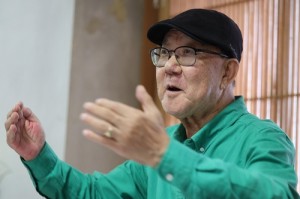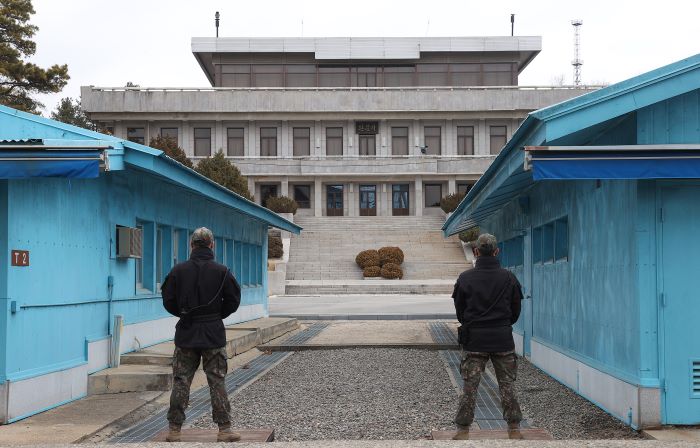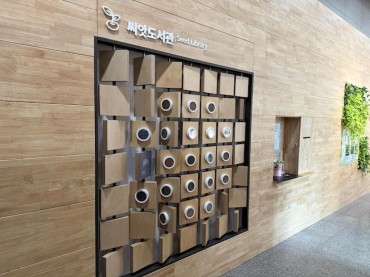
Kim Young-gyu, the longest-serving public affairs officer at the United States Forces Korea, speaks during an interview with Yonhap News Agency in Seoul on Oct. 19, 2023. (Yonhap)
SEOUL, Oct. 21 (Korea Bizwire) –The truce village of Panmunjom is the last remaining Cold War frontier inside the heavily-guarded demilitarized zone (DMZ) separating the two Koreas, but to Kim Young-gyu, the longest-serving public affairs officer at the United States Forces Korea (USFK), it is a place full of personal memories.
The 76-year-old Kim has traveled to Panmunjom, also known as the Joint Security Area, over 1,000 times during his 44 years in service, having witnessed historic meetings, heart-touching events and hair-raising incidents.
Kim first set foot in Panmunjom in 1976 when he was serving as a Korean Augmentation Troops to the U.S. Army soldier, which changed the course of his life.
When two American soldiers were axed to death by North Koreans inside the DMZ over a poplar tree in August 1976, Kim was dispatched to the truce village to cover the incident as a reporter of the Indianhead Magazine affiliated with the U.S. Army’s 2nd Infantry Division.
“With an armored vest and a camera, I got on board a helicopter … When I arrived in Panmunjom, I was scared as tanks were nearby, facing northward,” Kim said during a recent interview with Yonhap News Agency in Seoul. “It was later discovered that the U.S. troops were on standby for a potential operation in case of North Korean provocations.”

In this file photo, soldiers stand on the southern side of the Joint Security Area, also known as Panmunjom, on March 3, 2023. (Yonhap)
Three years after the incident, Kim was discharged from his mandatory military service and began working as public affairs officer at the 2nd Infantry division in Dongducheon, just south of the DMZ. He moved to the USFK’s public affairs office in 1985.
Serving as the liaison for the USFK as well as the United Nations Command and the S. Korea-U.S. Combined Command, Kim is known as the “living history of the bilateral alliance” who has played a bridging role between the U.S military and Korean society.
About 28,500 American troops are stationed in South Korea, as the 1950-53 Korean War ended in a ceasefire, not a peace treaty.
As Panmunjom has served as a venue for inter-Korean talks, Kim said he had rare opportunities to talk with North Korean journalists and understand the reality of a divided peninsula from a broader perspective.
“Being able to observe inter-Korean relations through the eyes of North Korean journalists at Panmunjom was one of the rewarding aspects of working as a USFK public relations officer,” Kim said.
One of his vivid personal memories at Panmunjom is related to Lim Su-kyung, a former pro-unification activist who made an unauthorized trip to attend a youth event in Pyongyang in 1989 and returned to South Korea via the truce village.
Kim escorted Lim and saw her make a speech standing on the military demarcation line. Then she was arrested by South Korean authorities on charges of violating the National Security Act by crossing the border without authorization.
As South Korean journalists were not allowed to cover the historic incident at the site, Kim took the role of briefing the event to the domestic press.
“As a public relations officer, I had to tell the facts to reporters, restraining my personal feelings,” Kim said, adding that he confessed his complicated emotions to a priest.
Kim said the bilateral alliance took a turn when two South Korean schoolgirls were crushed to death by a U.S. military convoy on a highway in Yangju, just north of Seoul, in 2002.
The American soldiers involved were found not guilty of negligent homicide in the court-martial, inflaming anti-American sentiment in South Korea and sparking a series of candlelight vigils in protest of their deaths.
In light of the tragic incident, Kim said the U.S. military leadership saw the need to closely communicate with the South Korean public and created a community engagement initiative, “Good Neighbor Program,” in 2003.
“This is an incident that we need to deeply reflect upon,” he said. “Following the incident, the USFK created the ‘Good Neighbor Program’ to promote a better understanding of U.S. forces among the Korean people. The ‘Good Neighbor Award’ has been granted as part of the program.”
One of the most frequent questions he has received from foreign press during guided tours is this: “When do you think the two Koreas will be reunified?” Kim said he consistently answers, “It won’t happen in the near future.”
“While covering Panmunjom meetings, I met several North Korean journalists. When you meet and talk with them, you realize how different their perspectives are,” he said. “After more than 70 years of living apart, the thoughts of people from North and South Korea have diverged significantly, making reunification not an easy task.”
Although Kim is set to retire from the USFK on Oct. 31, he plans to continue his role as a bridge between the U.S. military and Korean society through media-related activities.
“I want to share my personal life stories with others. I see the value in it,” he said.
(Yonhap)






